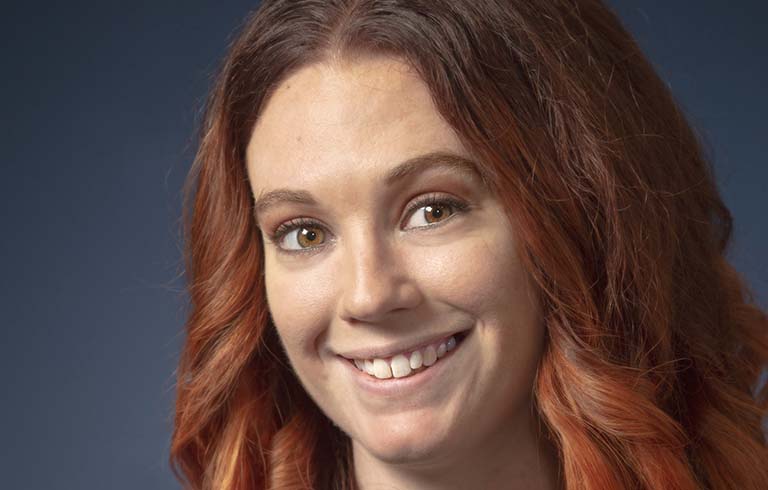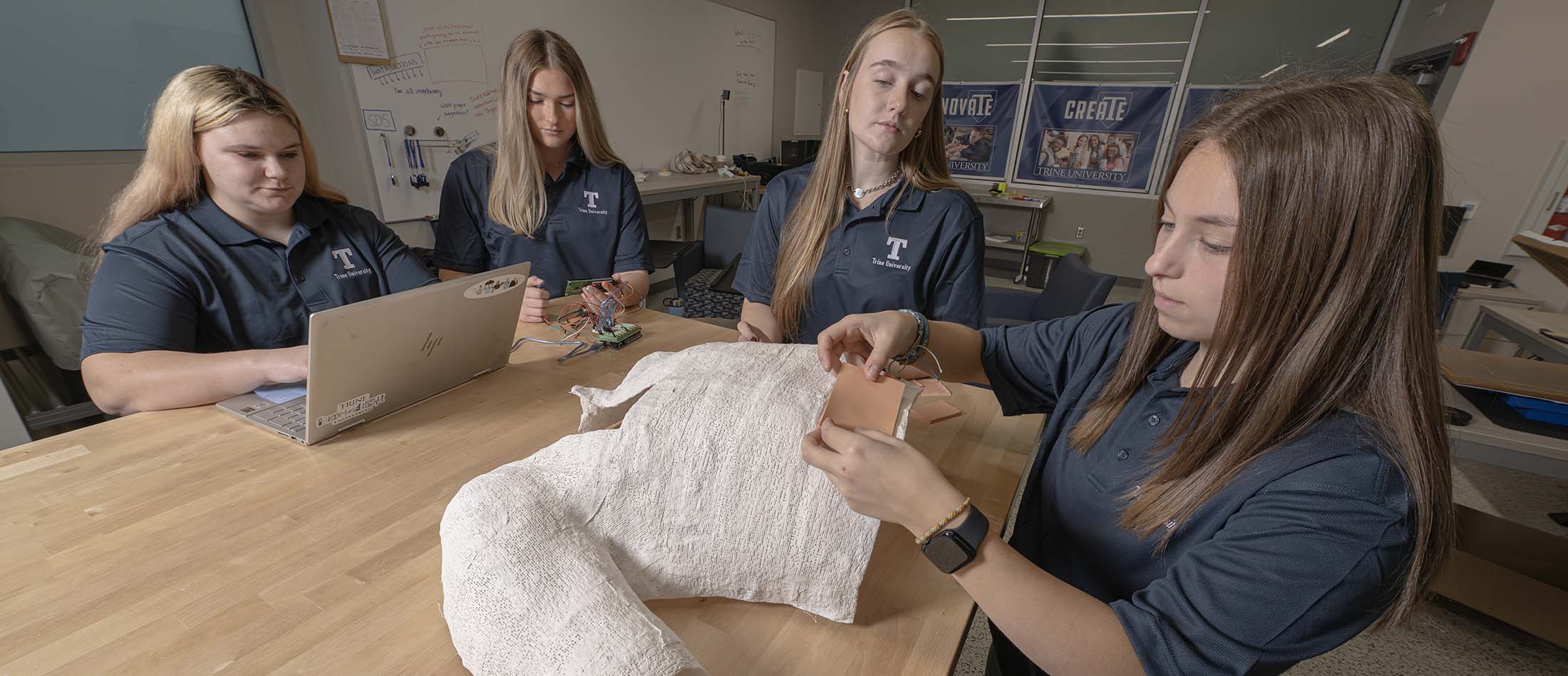
Gaskill named executive director for Education One
Education One, the charter school authorizer at Trine University, has named Emily Gaskill as its executive director.
May 21, 2025

Central lines (catheters inserted into large veins) are commonly used to deliver medications or specialized treatment, or for prolonged IV therapy.
However, errors in inserting central lines can result in medical complications, with data from the National Institutes of Health suggesting this occurs in up to 20% of cases.
Current commercially available training devices only allow learners to experience a portion of the procedure, with the balance either verbalized or completed on a separate device.
To help better prepare medical professionals to perform central line insertion, Parkview Health partnered with a senior design team of Trine University engineering students to design an improved, more complete training device.
“The goal of our central line trainer project is to create an all-in-one trainer that allows our learners to walk in and complete the procedure from start to finish, just like they would in the clinical environment,” said John Lozo, healthcare simulation specialist at Parkview Health.
Conquering a challenge, making a difference
The Trine team consisted of Brooke Hoag, a mechanical engineering major from Portage, Michigan, and biomedical engineering majors Hailey Jakubowski of Howell, Michigan, Margaret Armintrout of Bonner Springs, Kansas, and Paige Hull of New Lenox, Illinois.
Team members were drawn to the project by the challenge it presented and the opportunity to have a real-world impact.
“Designing a functional medical training device that allows healthcare professionals to practice procedures safely, without the need to perform them on actual patients, is a meaningful opportunity to contribute to the field,” said Hull. “As engineers, our mission is to improve lives through innovative solutions, and this project reflects that purpose.”
“This project was complex from the start,” Armintrout, who served as the team lead, commented. “It wasn’t something I knew how to do right away — it was something I had to grow into. It challenged me intellectually, creatively and emotionally. I learned to think differently, problem-solve in real time and step way outside of my comfort zone.”
Process and challenges
The Trine group began by meeting with Lozo and his team at Parkview to understand current challenges in training.
After the initial meeting, they started brainstorming design concepts and features that would meet Parkview’s needs.
“I learned early on that real-world design is never just step-by-step: It’s messy, unpredictable, and constantly evolving,” said Armintrout. “We started by breaking the system into pieces and weighing all our options using design matrices. Every component had to be carefully considered, both in terms of functionality and realism.”
“We conducted background research, reviewed existing models and began prototyping,” Jakubowski explained. “Our process included material testing for skin realism, fluid flow analysis to simulate pressure, and sensor integration to detect accurate needle placement.”
After laying the groundwork with design during the fall semester, the team moved to the manufacturing phase in the spring.
“Once we moved into manufacturing, new challenges kept popping up,” Armintrout noted. “We’d realize a part didn’t work the way we expected or that something we thought would be simple ended up being incredibly complex.”
Hoag discovered that available computers were not up to combining a 3D scan with a part created in NX and had to develop a reverse mold by printing multiple pieces and adhering them together. Armintrout found some of the electrical components needed for the trainer required additional parts, resulting in redesigning and rewiring those systems.
“Adding components like the diaphragm and peristaltic pumps, touch sensors, buzzer, and LEDs meant writing and debugging a lot of code—and every new feature introduced the possibility of something else breaking,” Armintrout said.
In addition, the entire team came together to deal with leaks that developed in various iterations of the device.
“Given that our design incorporates a fluid flow system alongside electrical components, ensuring a leak-proof setup was critical to both functionality and safety,” said Hull. “Resolving this issue required extensive collaboration, troubleshooting and problem-solving, with each team member dedicating countless hours to testing solutions and refining the system.”
The team kept in constant communication with Parkview throughout the process, receiving and implementing feedback on areas including project direction, desired components and preferred materials.
“They had a clear vision for what they wanted this device to be, and we really tried to honor that while also using our engineering knowledge to enhance it,” said Armintrout.
Real-time feedback
The final trainer developed by the Trine students provides real-time feedback by detecting errors, such as improper needle placement or excessive depth, using the integrated sensors.
Lozo said it will primarily be used with residents who are required to learn how to place central lines. Other Parkview providers also will utilize the device for periodic training events.
“This is a rather complex project, with a few parts that could have likely been dedicated projects in and of themselves, but Hailey, Maggie, Brooke and Paige’s hard work over the year resulted in a prototype encompassing nearly every aspect requested of them,” he said. “There is some refinement work that needs to be completed prior to implementation, but they had already identified the various improvements they wanted to make. They have laid the foundational work that will lead to the improved training of our providers and clinical staff!”
Similarly, the Trine students said they are very proud of their final product.
“It reflects months of dedication, teamwork and creative problem-solving,” said Jakubowski. “We met our project goals and, more importantly, we developed something that can truly enhance medical training experiences.”
They also enjoyed bonding together to complete the project, and appreciated the support of Trine faculty including Beau Watson, Ph.D., who served as project manager.
“I had the best team I could’ve asked for. My team showed up, every day, willing to do the hard stuff. Even when it wasn’t ‘their part’ of the project, they still stepped in and helped,” said Armintrout. “That kind of support made all the difference.”
“I’m also extremely thankful to our BME faculty, especially Dr. Watson, who guided us through this wild process and gave us the space to learn, fail and grow.”
“His encouragement and leadership consistently pushed us to reach our highest potential, and we are grateful for his role in our success,” agreed Hull.
Photo: From left, Trine University students Margaret Armintrout, Hailey Jakubowski, Paige Hull and Brooke Hoag designed a training device for Parkview Health to help better prepare medical professionals to perform central line insertion. (Photo by Dean Orewiler)